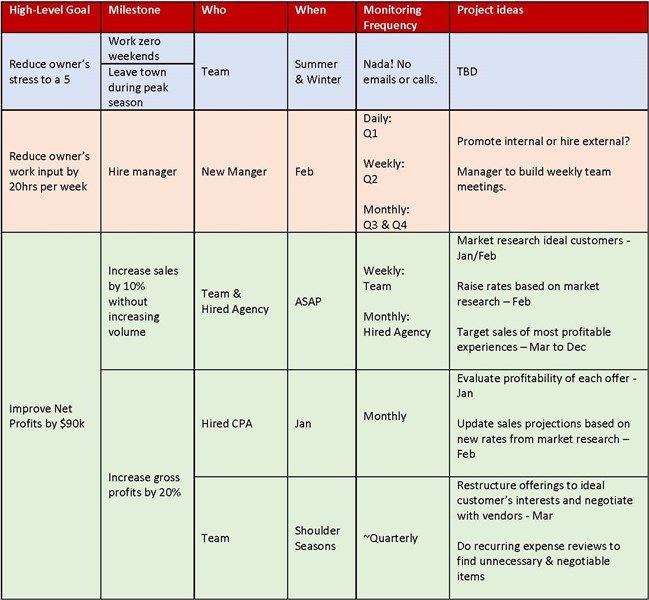By: Zeb Smith, Ascent Business Financial Strategies
Each new year we reflect on last year’s resolutions, evaluate our goals, and design a plan for the year ahead. As business owners we check last year’s actuals to expectations and use whatever we learned this year to make next year even better.
We do this personally & we do this for our businesses – as both are highly intertwined.
Unfortunately, all too often I see annual business planning approached haphazardly or without connecting the dots between personal & business goals. Resulting in early bailouts, incomplete executions, and failed plans. On a personal level this means below-par pay, recurring year-by-year stressors, unhappy employees & disgruntled owners.
On the brighter side - when approached systematically - the year-by-year results are beautiful: stress levels are reduced, pay and profits are improved, employees are happier & more bought-in to the business’s future, and owners can breathe a sigh of relief.
A comprehensive business plan includes articulating your personal high-level goals, business-level goals, metrics, milestones, and monitoring activities.
High-Level Goals
Your high-level goals have little to do with your business. They are your personal financial and non-financial goals. The metrics used to benchmark your high-level goals are insanely simple; sometimes painfully simple.
Each year you want to quantify your total owner compensation, stress levels, and personal accomplishments. Reflect on each and ask yourself:
-
Are you happy with last year’s results?
-
What do you need form each to be truly happy this year?
-
How would your life improve with said needs met?
Write-out your responses and use a one to ten scale to quantify your ‘happiness score’ for each.
If you want to use a template with all questions and scales already built in, then here you go.
Business-Level Goals
You want to evaluate your business-level financial & non-financial goals as well.
Did your business meet or exceed last year’s net profit and owner compensation needs? Why or why not? Were the ending figures because of one-time anomalies or sustained trends?
Review the metrics, KPIs, and results of your non-financial goals. These include your primary stakeholders: customers, employees, and key vendors.
Did you meet or exceed last year’s non-financial goals? Why or why not?
Continue to dig deeper to understand the ‘whys’ behind last year’s results until you have a thorough understanding of what happened and how-to proceed this year.
Metrics & Milestones
The surest way to achieve your goals is to build metrics and milestones focused on each. Doing so provides your team with actionable direction and provides you the ability to quickly evaluate your business’s progress.
Metrics
You want to isolate, adopt, and track both high-level and business-level metrics.
The high-level metrics are simple metrics targeting each of your high-level goals. You want to keep these simple for a single reason: To be bluntly honest on whether your business is supporting your high-level goals or not.
Here are my suggested metrics for each of your high-level goals:

Using your desired high-level goal results, create a month-by-month table to ‘trend’ the progress toward your high-level goals. Use last year’s monthly results to incorporate any seasonality.
Use each month’s metric as benchmarks to evaluate your progress.
Here is an example of an owner-operated two-season travel business:

For the business-level metrics, isolate a few targeted metrics that support each of your business-level goals. These metrics will be the benchmarks used to guide your managers and evaluate their performance.
The business-level financial metrics often include revenue generating activities and a budget for expense management. The business-level non-financial metrics involve your key stakeholders.
A word of caution: There are hundreds of business-level metrics to adopt. It is super easy to go overboard with these. I highly suggest you pick only a few that best support your high-level goals.
Build a monthly progress chart for the business-level metrics you identified.
If you want the best business-level metrics for outfitters, then check out my e-book, “13 Key Metrics To Grow A Profitable Adventure Business.”
Milestones
Milestones are the expectations you set for your primary stakeholders. The timely completion of your milestones is how well they demonstrate buy-in to completing your goals. Milestones define:
Milestones DO NOT answer ‘how’ things get done. Projects spell out ‘how’ things will be done and are designed later in the year. you may think up a few potential projects when defining your milestones but do not waste much time on designing projects at this point.
Here are some examples of a few milestones targeting top-level goals:

Monitoring Activities
Your plan is built! Now you simply need to follow-through with your plan to see results and achieve your goals. To do this, you will need to monitor your progress via a reporting dashboard and recurring time blocks.
Reporting Dashboards
Your reporting dashboard is a centralized place where all metrics and milestones are reported. I use a whiteboard in my office where I write my metric results at the end of each month. I also use a web-based program that aggregates data from other various tools used within my business. This dashboard accumulates the financial and non-financial data I need to track, review, and analyze my metrics. It even tracks my milestones and can be shared with my team members to delegate projects and tasks.
Recurring time blocks
At the very least you want to check your high-level and business-level metrics once per month. Use this time to check results to your monthly benchmark calendar and evaluate your milestone progress.
Where plans fail
As simple as it is, the monitoring phase is where nearly all plans fail. Owners schedule their time blocks and return to work. One time block gets skipped, then another, and before they know it these owners are building next year’s plan with unnoticeably different goals to the year before. These owners tell themselves, “I didn’t get it done this year, but I’ll make it a priority next year.”
We all know how what happens next. Do not be one of these owners! Make a commitment to yourself and review your plan progress every month. Stick to it all year: even during peak and shoulder seasons.
I highly encourage you include a third party to review your metrics and milestone progress with you. Invite someone to celebrate your wins, hold you accountable to your goals, and potentially set you straight when things start to slide.
About the Author

If you want more information to help build your annual plan, then I invite you to download my e-book “Work Less, Make More A Guide For Adventure Travel Business Owners.”
If you have questions, or want to discuss business planning services, then give me a call at 970-426-5737 or shoot me an email at zeb@ascentunlimited.com.